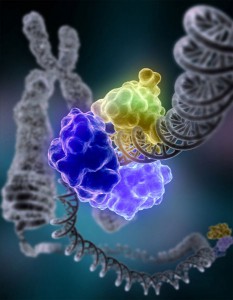![]() Taking into account the importance of the role that genetic recombination plays in evolution, adaptation, survival, and – perhaps most importantly – sex, we know surprisingly little about the molecular foundations of this phenomenon. What we do know is that genetic recombination is not a completely random process; that it follows a pattern. Some chromosomal regions are more, and some less, likely to be affected by double-stranded breaks – and the recombination events that follow. Areas with a high frequency of recombination have been appropriately dubbed ‘recombination hotspots’.
Taking into account the importance of the role that genetic recombination plays in evolution, adaptation, survival, and – perhaps most importantly – sex, we know surprisingly little about the molecular foundations of this phenomenon. What we do know is that genetic recombination is not a completely random process; that it follows a pattern. Some chromosomal regions are more, and some less, likely to be affected by double-stranded breaks – and the recombination events that follow. Areas with a high frequency of recombination have been appropriately dubbed ‘recombination hotspots’.
Now, recombination hotspots are a bit of an enigma themselves: for a long time no one could put their finger on how these hotspots are defined – or chosen. But, as it happens, something else’s fingers are involved: those of the zinc finger protein PRDM9. The mystery slowly started to unveil in 2010 when three articles in Science identified PRDM9 as a key player in the process of recombination hotspot determination.

Thanks to those papers and subsequent work, we know that PRDM9 binds to specific DNA sequences, activating chromatin and guiding the generation of double-stranded breakpoints. But there is still some confusion regarding the make-up of these DNA sequences, and this is the problem that Petkov and colleagues address in an article published in Genome Biology last week.
In the article, Petkov and colleagues take two variants of mouse PRDM9, express them in E. coli and then assess which sequences in four known hotspots the protein binds to, and how. As it turns out, for the same variant of PRDM9 there is very little sequence similarity between the different binding sites, and the specificity of each of the protein’s dozen zinc fingers seems to be context-dependent. As part of this survey, the authors also identify the shortest DNA sequence required to bind PRDM9.
The data collected by Petkov and colleagues represents one of the most detailed and comprehensive PRDM9 DNA-binding maps described to date. Their work, however, raises more questions than it answers: instead of one consensus sequence, the article identifies a whole collection; instead of defining a set of rules for PRDM9 interactions with DNA, Petkov and colleagues suggest that its zinc fingers are quite fickle in this regard. And this is all already apparent in an in vitro study – PRDM9 behavior may be revealed as even more complex when we move to in vivo studies of this capricious protein, and to human-dedicated models.
Comments